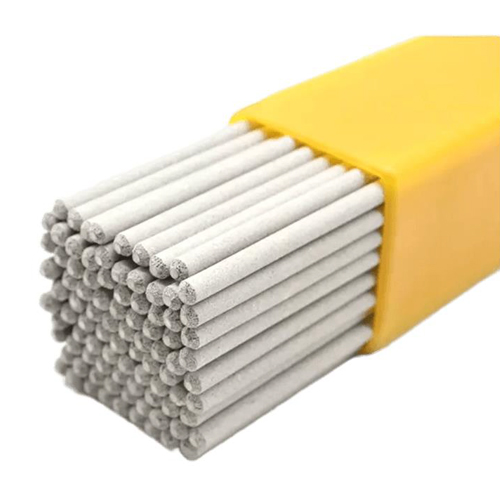

íshín-347S has nominal composition (wt. %) of weld metal is 19.5 Cr, 10 Ni with Nb or Nb plus Ta added as a stabilizer. Either of these additions reduces the possibility of intergranular chromium carbide precipitation and thus increases resistance to intergranular corrosion. These electrodes are usually used for welding chromium-nickel alloys of similar compositions stabilized either with niobium or titanium. Electrodes depositing titanium as a stabilizing element are not commercially available because titanium is not readily transferred across the arc in shielded metal arc welding. Although niobium is the stabilizing element usually specified in Type 347 alloys, it should be recognized that tantalum is also present. Tantalum and niobium are almost equally effective in stabilizing carbon and in providing high-temperature strength. This specification recognizes the usual commercial practice of reporting niobium as the sum of niobium plus tantalum. If dilution by the base metal produces a low-ferrite or fully austenitic weld metal deposit, crack sensitivity of the weld may increase substantially.
Some applications, especially that involving high-temperature service, are adversely affected if the ferrite content is too high. Consequently, high-ferrite content should not be specified unless tests prove it to be necessary.
These electrodes are designed for flat and horizontal fillet welding. In practice, most of these electrodes give higher deposition rates than their all-positional counterparts owing to their thicker coatings that contain higher levels of metal powders. The thicker coating gives larger fillet welds that are typically flat to concave. It also reduces the effects of core wire overheating, making 450 mm long electrodes possible for the larger electrodes, even with stainless steel core wire. Higher currents are usually required to achieve the necessary penetration compared to the all-positional types. The slag system of these electrodes is like those of the - 16 and -17 designations. The resulting slag may be more fluid and even slower freezing than that from -17 electrodes. The -26 electrodes are recommended for welding only in flat and horizontal fillet positions. Out of position welding may be possible with electrode sizes up to 3.2 mm diameter.
Storage and Drying Conditions: Hydrogen can have adverse effects on welds in some steels under certain conditions. One source of this hydrogen is moisture in the electrode coverings. For this reason, the proper storage, treatment, and handling of electrodes are necessary.
Holding Ovens: 125°C–150°C.
Drying Conditions: 250°C–425°C for 1 hour prior to use.
CHEMICAL COMPOSITION OF UNDILUTED WELD
|
C |
Cr |
Ni |
Mo |
Nb+Ta |
Mn |
Si |
P |
S |
N |
Cu |
Others |
|
0.08 |
18.0-21.0 |
9.0-11.0 |
0.75 |
NS |
0.5-2.5 |
1.00 |
0.04 |
0.03 |
NS |
0.75 |
NS |
Single values are maxima, except where specified otherwise.
ALL-WELD-METAL MECHANICAL PROPERTIES
|
Tensile Strength, MPa |
Yield Strength, At 0.2% Offset, MPa |
Elongation % |
Lateral Expansion, mm |
Charpy V-Notch Impact at NS°C, Joules |
|
550 |
NS |
30 |
NS |
NS |
Single values are minimal.
ELECTRODE SIZE & WELDING CURRENT (AC and DCEP)
|
DIAMETER, mm |
LENGTH, mm |
Amperes |
|
2.50 |
350 |
65-90 |
|
3.15, 3.20 |
350 |
90-120 |
|
4.00 |
350 |
120-150 |
|
5.00 |
350 |
160-200 |
WARNING: Safety and health information is available from many sources, including, but not limited to Safety and Health Fact Sheets listed in A11.3, ANSI Z49.1 Safety in Welding, Cutting, and Allied Processes published by the American Welding Society, 8669 Doral Blvd., Suite 130, Doral, FL 33166., and applicable federal and state regulations. The Safety and Health Fact Sheets are revised, and additional sheets added periodically.
